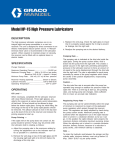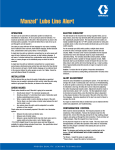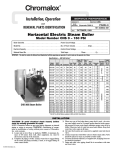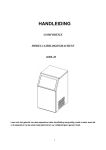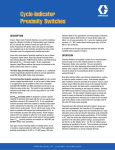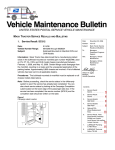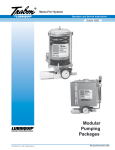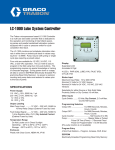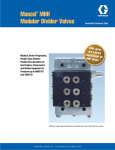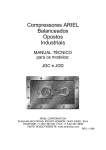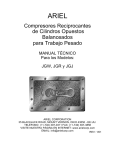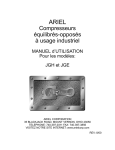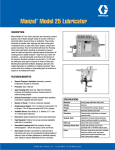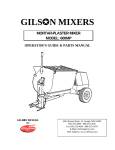Download Graco Pneumatic/Electric Lube Sentry Valve User's Manual
Transcript
Pneumatic/Electric Lube Sentry Valve ELECTRIC LUBE SENTRY VALVE PNEUMATIC LUBE SENTRY VALVE OPERATION: Initiate lubricant flow from the lube pump serving the divider valve or pump to point system (until flow has been established, the electric or pneumatic circuit to the Lube Sentry must be bypassed). Lubricant passing through the hydraulic section of the valve (See Figure 1 or 2) from port (1) to port (2) moves to piston (3) in the direction of the arrow. The actuator rod (4) is attached to piston (3) and simultaneously moves in the same direction allowing the directional spool (5) in the air valve of the Pneumatic Lube Sentry (See Figure 1) to permit air to flow between port “A” and port “C” or tripping the microswitch(es). (See Figure 2 Note 2 on the Electric Lube Sentry.) The Lube Sentry is now in a flow position. When lubricant flow stops, spring (6) returns piston (3) in the opposite direction, closing the porting to the lube outlet (7). The lubricant ahead of piston (3) is forced back through the adjustable needle valve (8) at a controlled rate. As piston (3) returns to the right, the attached actuator rod (4) moves the Pneumatic Lube Sentry directional spool (5) permitting air to now flow between port “A” and port “B” (See Figure 1), or changing the position of the microswitch(es) (See Figure 2 Note 2) on the Electric Lube Sentry. The Lube Sentry is now in a no-flow condition. Figure 1 shows a typical no-flow position. Flow - Green Light - ON; Red Light - OFF No-Flow - Red Light - ON; Green Light - OFF Adjusting needle valve (8) clockwise increases shutdown time. A counterclockwise adjustment decreases the shutdown time. Note 1: Pneumatic Valve Operation (During Lubricant Flow) Note 2: FLOW CONDITION : For Closed Contact: Use Red and Blue Wires (Red Common) For Open Contact: Use Red and White Wires (Red Common) Operation Port “A” Port “B” Port “C” Norm. Open Air In Plugged Air Out Norm. Closed Air Out Air In Plugged Figure 1. Pneumatic Lube Sentry Valve NO-FLOW CONDITION: For Open Contact: Use Red and Blue Wires (Red Common) For Closed Contact: Use Red and White Wires (Red Common) CAUTION: If only two of the three wires are used, tape un-used wire. Figure 2. Electric Lube Sentry Valve 45425 Manzel® Pneumatic/Electric Lube Sentry Valve INSTALLATION General Lube Line Connection 1. The Lube Sentry Valve should be located in the lube line downstream of pump, filters, and controls, but ahead of the master divider valve. (A high-pressure line filter placed after the pump is insurance against system plugging due to oil-born dirt.) 2. A pressure rupture assembly (Disk Relief Type) must be located in the main lube line between the pump and the line filter. 3. NOTE: Do not use below minimum recommended flow rates or inconsistent shutdown times occur. Always install Lube Sentry with “LUBE OUT” port up, to permit natural air purging of the device. Graph 1. Minimum Flow Rate General Shutdown Reaction Adjustment 1. See graphs for minimum flow rates, with various viscosity oils, and shutdown time recommendations. 2. Start with the adjustment screw (Figures 1 & 2, Item 8) flush with end of housing. Turn on lube system with pump discharging oil at normal flow rate and pressure. 3. Slowly rotate adjustment screw clockwise until the electric switch/air valve changes mode (flow condition). 4. Stop oil flow and note time for electric switch air valve to change mode (no-flow condition). 5. Start normal flow of oil and note that the electric switch/air valve changes mode (flow condition) within two minutes and remains in this mode as long as normal oil flow continues. 6. For positive shutdown indication on the Electric Lube Sentry, an ohmmeter or continuity meter should be connected to wiring as follows: No flow condition – continuity between red and white wires. Flow condition – continuity between red and blue wires. Caution – In an explosive atmosphere, use only approved device for checking continuity 7. This is the minimum shutdown time attainable for the application. The shutdown time can be increased by continuing to turn the adjustment screw clockwise. Caution – Do not adjust shutdown time greater than shown on graphs or inconsistent shutdown time will result. Pneumatic Lube Sentry Valve Installation Pneumatic Connections A. Series Type (in-line) Safety Control Pneumatic Circuits (See Figure 3) 1. Trace pneumatic safety circuits from the source of its take-off air supply through the various safety devices used on the engine and compressor to the entrance of the pilot air port (bonnet port) on the safety control valve or gas shut-off valve. 2. Select the most convenient location to break into the air circuit, either between two other safety devices or between the last safety device and the bonnet port of the safety control valve. NOTE: At minimum flow rate, the shutdown time is not adjustable. Times indicated are approximate results when the attached procedure is followed. Attempting to increase the shutdown time will result in inconsistent shutdown time. Graph 2. Minimum Shutdown Time 3. Break the air circuit at the selected point and tube the Lube Sentry Valve into the circuit with air flow entering port “A” and leaving port “C” (See Figure 1). If gas is used as the control medium rather than air, tube the exhaust port “B” into a suitable vent line. CAUTION – Never plug port in series type shutdown circuits. 4. To test device for operation, start engine to initiate flow in the divider valve system. Operation of the air valve within the Lube Sentry will be observed as the tripping out of the reset latch (manual override) lever on the safety control valve (see Figure 3), and the continued operation of the engine. After a short interval of running during which the engine and compressor receive sufficient lubrication and all other safety devices move to the RUN position, dump the output of the pumps serving the divider valve systems by removing the pump blowout disc or a pipe plug from the pump manifold assembly. When the flow to the distribution system stops, the Lube Sentry should operate to dump the pressure in the pneumatic safety circuit, dropping out the safety control valve to stop the engine. (If shutdown action is sluggish, reduce the setting of the adjustable orifice through which air for the safety circuit passes. Page 2 45425 Manzel® Pneumatic/Electric Lube Sentry Valve The Lube Sentry is provided with a 1/8” air valve. If the control orifice for the safety system is too large, air will be supplied to the Lube Sentry too quickly to permit it to dump properly.) housing, consisting of conduit elbow and cap, nipple, and adaptor by loosening and removing the adaptor, (Figure 7, Item 31) from the switch housing. A pneumatic relay may be operated by the Lube Sentry (see Figure 4). 3. Loosen setscrew (Item 26) located on bottom of switch body. B. Parallel Type Safety Control Pneumatic Circuits (See Figure 5) 4. Actuating piston must be completely extended (Item 15). 5. Rotate switch enclosure screw (Item 23) clockwise until switch just actuates. (Continuity is obtained between red and white wires.) Rotate additonal 1/4 turn after switch actuates. 6. Tighten setscrew (Item 26) to lock nylon ball (Item 25) against switch enclosure screw. 7. If microswitch is defective, replace. 8. Re-adjust switch. 1. Parallel type safety circuits rely on their devices to dump the pilot control pressure on the safety control valve in case of trouble. This control pressure is supplied to the pilot (bonnet) port of the safety shutdown valve through an adjustable orifice which permits enough air to enter the circuit to maintain pressure on the port. When any safety device operates, the pilot pressure is dumped, with the control orifice preventing sufficient air to enter the system to maintain pressure. 2. The Lube Sentry should be teed in to the line serving the pilot port of the safety shutdown valve. 3. Connect port “B” into the safety circuit. 4. Plug port “C”. 5. Port “A” (exhaust) may be connected to a vent line if necessary. 6. To test device for operation see item 4 under Series Type. Electric Lube Sentry Valve Installation Electric Switch Adjustment and Replacement Figure 3. Typical Series Installation of Pneumatic Engine Shutdown Circuit The electrical end of the Lube Sentry has been adjusted correctly at the factory. If the electric switch assembly is replaced, repairs required or adjustment necessary, proceed as follows: Warning: Never remove the Lube Sentry Electric Switch Assembly from the Actuator Assembly or make any adjustments to the Electric Switch without first being sure there is NO Electricity Present at the Lube Sentry. To Replace Electric Switch Assembly 1. After determining there is no electricity to the Lube Sentry, remove the switch assembly from the actuator assembly by removing the four-socket head screws holding the two assemblies together, being careful not to scratch the mating surfaces. 2. Be sure no corrosion or dirt is present. In a no-flow condition, the actuator rod should extend approx. 5/32 inches beyond the actuator rod housing. 3. Replace electric switch assembly. Caution: Do not reassemble if scratches, dirt, or corrosion are present on mating surfaces of switch and actuator assembly. To Adjust Electric Switch Assembly 1. 2. Page 3 With no lubricant flowing, Lube Sentry should be in shutdown or warning position (switch actuated). You should show continuity between red and white wires, if not, the microswitch is misadjusted or broken. If adjustment is required, remove the electrical connection Figure 4. Typical Installation with Pneumatic Indicating Relay NOTE: Installation of the Pneumatic Lube Sentry as shown on the drawing provides automatic signalling of cylinder lubrication trouble. No flow caused by pump failure, broken line or low oil supply will cause the Lube Sentry to operate, removing air pressure from the fuel valve and stopping the engine. Figure 5. Typical Parallel Gas Engine Installation of Lubriquip Pneumatic Lube Sentry with Fulton-Sylphon No. 530 Pneumatic Pilot Valve Ordering Information Figure 7. Switch Assembly for Electric Lube Sentry Description Part No. Old Part No. Item Pneumatic Lube Sentry, Complete 563506 527-100-190 22 Description Part No. Old Part No. Qty. Switch Assembly - Electric Lube Sentry 563504 527-100-170 Pneumatic Valve 563503 527-100-150 23* 1 • Switch Enclosure Screw 557355 503-680-000 Actuator 563502 527-100-130 1 24* • Microswitch Assembly 557757 527-100-210 Electric Lube Sentry, Complete 563505 1 527-100-180 25* • Nylon Ball, 5/32 in. 555781 504-706-000 Switch Assembly 563504 1 527-100-170 26* • Setscrew, 10-32 x 3/8 in. 556476 417-450-040 1 27* • Round Head Screw 555496 416-010-070 2 28* • Int. Lockwasher 555631 421-070-010 2 29* • Socket Head Srew, 1/4-20 x 1-3/4 556510 419-130-090 4 30 • Switch Housing 561008 527-100-090 1 31 • Adapter 557356 503-681-000 1 32 • Conduit Elbow w/Nipple 557384 507-912-000 1 563908 560-001-120 1 For more information on the Pneumatic or Electric Lube Sentry Valve consult Literature L15831 Figure 6. Actuator Assembly Item Description 1 Part No. Lube Sentry Actuator Assembly 563502 Old Part No. 527-100-130 Qty. 1 2 • Body (Matched Fit) 560999 527-100-000 1 3 • Piston (Matiched Fit) 561000 527-100-010 1 4* • Valve - Adjustment 561005 527-100-062 1 5* • Housing Adjustment Screw 561004 527-100-052 1 6* • O-Ring, Viton, 70 Duro 556560 422-041-140 2 7* • O-Ring, Viton, 70 Duro 556551 422-040-060 1 8* • Back-Up Ring 557719 527-000-760 2 9* • O-Ring 556554 422-040-110 1 10* • Setscrew, 1/4-20 x 1/4 Hex 555531 417-060-020 1 11* • Ball, 3/16, Steel 556328 401-030-030 1 Figure 8. Valve Assembly for Pneumatic Lube Sentry 12* • Spring-Piston Return 557753 527-100-110 1 Item 13* • O-Ring 556557 422-040-140 1 22 14* • Spacer, O-Ring Retaining 561009 527-100-100 1 23* 15* • Piston-Switch Actuating 561002 527-100-030 1 16* • Locking Screw, 3/8-24 x 3/16 556470 416-700-780 17* • Back-Up Ring 556584 18* • O-Ring 556553 19 • Screw - Piston Enclosure 20 * Electric Switch Assembly Repair Kit Description Part No. Old Part No. Qty. Valve Assembly - Pneumatic Lube Senry 563503 527-100-150 1 • O-Ring, 70 Duro 555690 422-041-200 1 24* • O-Ring, 70 Duro 555685 422-040-220 1 1 25* • Air Valve Spring 557353 503-658-000 1 423-700-038 1 26* • Valve Cartridge 557354 503-659-000 1 422-040-080 1 27* • Spring Guide 561011 527-100-320 1 561003 527-100-040 1 28* • Socket Head Screw, 1/4-20 x 1-3/4 556510 419-130-090 4 • Houseing - 5 W. Act. Piston 561001 527-100-020 1 29 • Air Valve Housing 561006 527-100-070 1 – Adjustment Screw & Housing Only 564405 527-100-370 1 30 • Air Valve Enclosure Screw 561007 527-100-080 1 * Actuator Assembly Repair Kit 564436 560-001-130 1 * Pneumatic Lube Sentry Repair Kit 563907 560-001-110 1 Specifications Material Steel Operating Temperature -20ºF to 180ºF (-29ºC to 82ºC) Max Pressure 6,000 psi (414 bar) Max Air Pressure (Pneu.) 125 psi (8 bar) (1) Flow Rate (per day) 4 - 400 pints (1.89 - 189.2 liters) Elecrical Rating Pressure Drop 250 psi (17 bar) Seals Viton 1) 5 amps @ 125/250 VAC 2) A, B or C @ 28 VDC (A) Inductive - 3 amp (B) Resistive - 5 amp (C) Max Inrush - 15 amp (1) Lubricant Oil (450 - 2,000 SUS) Net Weight 5 lb (2.265 kg) (1) Ref to Graph 1 All written and visual data contained in this document are based on the latest product information available at the time of publication. Graco reserves the right to make changes at any time without notice. Contact us today! To receive product information or talk with a Graco representative, call 800-533-9655 or visit us online at www.graco.com. ©2006-2009 Graco Inc. Form No. L45425 Rev. B 7/09 Printed in U.S.A. All other brand names or marks are used for identification purposes and are trademarks of their respective owners. All written and visual data contained in this document are based on the latest product information available at the time of publication. Graco reserves the right to make changes at any time without notice.




